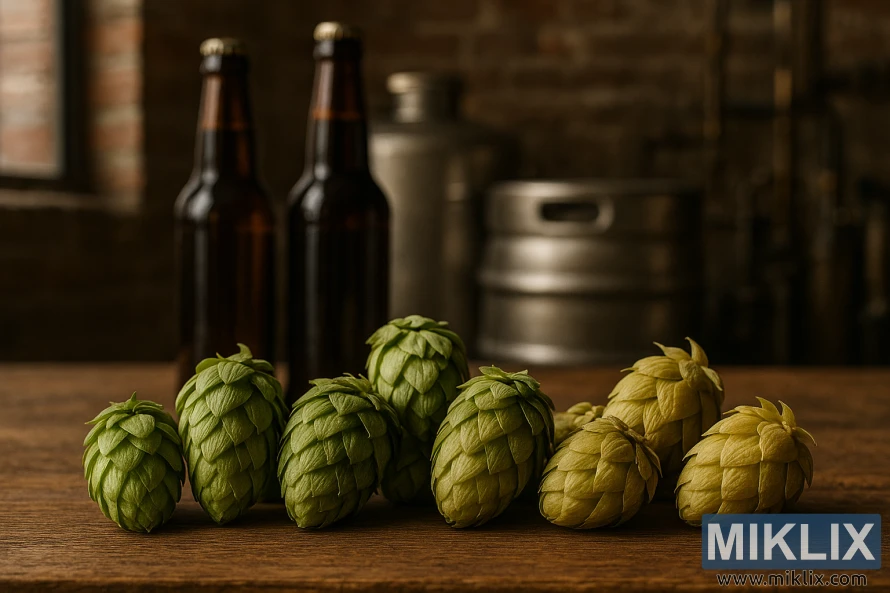Image: Cascade, Centennial, and Atlas Hops
Published: August 30, 2025 at 8:56:23 AM UTC
Last updated: September 26, 2025 at 9:21:16 PM UTC
Close-up still life of Cascade, Centennial, and Atlas hops with bottles and kegs, highlighting their role in flavorful beer brewing.
The photograph is a richly detailed still life that speaks to both the raw materials of brewing and the artistry that elevates them into something greater. In the foreground, an assortment of hop cones is arranged carefully across a rustic wooden surface, their shapes and colors inviting close study. Some of the cones are bright and vibrant green, their bracts fresh and tightly layered, while others lean toward a paler, golden hue, suggesting either a different variety or cones at a slightly different stage of curing. Together, they form a visual dialogue, a spectrum of possibility that hints at the remarkable diversity within the world of hops. Each cone is unique, yet all share the characteristic conical structure that makes hops so distinctive, their overlapping leaves resembling the scales of an ancient botanical artifact, sculpted as much for beauty as for function.
The natural side lighting enhances these details, casting soft shadows that give depth to the cones and highlight the subtle textures of their surfaces. The gentle glow suggests the presence of nearby daylight filtering through a window, imbuing the composition with warmth and authenticity. The wooden surface beneath the hops, with its grain and imperfections, further anchors the scene in rustic craftsmanship, evoking the tactile connection between farmer, brewer, and ingredient. This is not an overly polished setting but one rooted in the real spaces where hops are harvested, sorted, and ultimately transformed into beer.
In the middle ground, two dark glass bottles stand upright, their clean, simple lines offering a striking contrast to the organic forms of the hops. Behind them, the rounded shape of a stainless steel keg comes into focus, its silvery sheen catching faint reflections of the light. These objects are both symbolic and practical: the bottles and kegs represent the vessels through which the labor of brewing is shared with the world, from small tastings to large-scale gatherings. They bridge the journey from the raw ingredient lying on the table to the finished beer enjoyed in countless contexts. Their presence in the scene connects the hops not only to the brewing process but to the culture of beer itself—communal, celebratory, and enduring.
The background fades into a softened blur, but the elements remain recognizable enough to set the tone. Exposed brick walls hint at the rustic, industrial charm of a brewery setting, the kind of space where tradition and modernity often intersect. Pipes and brewing equipment loom in soft focus, their utilitarian forms reinforcing the technical precision required in brewing, while the rough brick walls remind us of the long history of the craft. Together, they balance each other, embodying both the timeless roots of brewing and the contemporary tools that make it possible today. The blur also serves to keep the viewer’s attention on the hops in the foreground, ensuring they remain the focal point while still contextualizing their role within the larger environment.
The overall mood is one of reverence and balance. By arranging the hops so prominently and surrounding them with subtle references to both raw materials and finished products, the image tells the complete story of brewing in a single frame. The rustic wood, the industrial keg, the glass bottles, and the exposed brickwork all orbit around the hops, emphasizing their central role in shaping the aroma, bitterness, and flavor profiles that define beer. It is an image that invites not just observation but reflection, reminding us that every glass of beer begins with something as humble and intricate as a hop cone, nurtured by nature and refined by human hands.
The image is related to: Hops in Beer Brewing: Atlas

